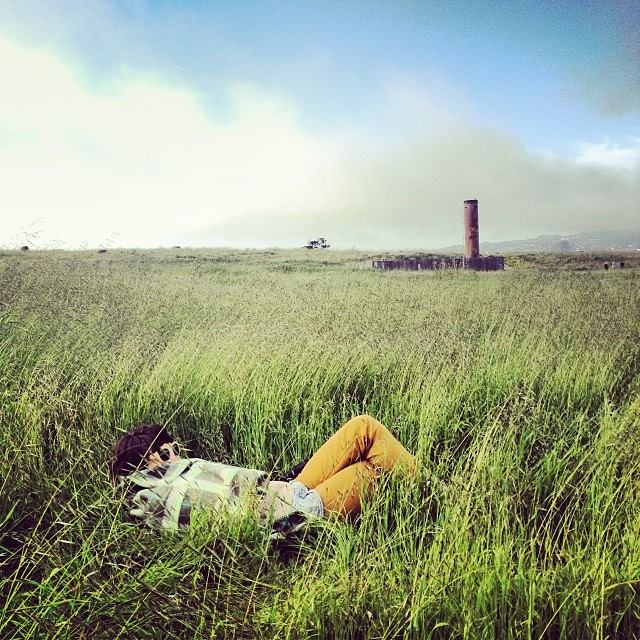Slow Down and Look Up
BY EMILY JONES
As I walk down the stairs inside the Bart Station at rush hour, I have an overhead view of the crowded platform below. Rows of people wait for the next train to carry them away from work. Scanning the crowd, I notice a common characteristic: most people stand with their face dropped toward a device in their hand. The back of their necks stretch out, shoulders concave, eyes squinting to read small print on a smartphone or tablet.
As a Pilates teacher, I can’t help but cringe; I spend a majority of my workday trying to help people understand what neutral posture is, and how building a sense of body awareness is the first step to alleviate many common complaints like back pain. Additionally, I can’t help but acknowledge the irony of this situation. Everyone is eagerly waiting to get on the train to be carried away from work, yet they are still consumed by a computer screen, as they likely have been all day. Waiting for an email, phone call, or updated news feed leaves us in a constant state of minor anxiety. This continual mode of stress is ultimately fatiguing and detrimental to mental and physical health. Habitually checking in to cyberspace removes us from engaging with the world around us, as well as inhabiting our own bodies.
I am lucky in my profession because I often get to see people at the happiest time of their day, engaged fully in movement and doing something to attend to physical, mental and emotional health. I started teaching Pilates four years ago. I was dealing with some injuries of my own and was interested in learning more about biomechanics while developing a career alongside dancing. I chose to teach Pilates because I appreciated the emphasis the form puts on the connection between mind and body. For each exercise, you are not just emulating a movement, but focusing on specific breathing and muscle engagement patterns. The form calls attention to movement within a neutral joint range and builds proprioceptive awareness. Its precision requires total concentration while in motion.
Teaching movement to everyone from athletes to non-movers, I have come to see various ways our psychological health is deeply intertwined with our physical well-being. This summer, a client who has been dealing with back pain on and off for years went on a camping trip for a week. While I was initially a bit worried about her sleeping on a the hard ground and carrying a heavy backpack around, I was curious about her unplugging from work for a week and being away from her desk. When she came home she declared that she had no pain for the first time in years. My suspicion was that not sitting in a desk for eight or more hours a day and leaving behind the stress of work freed some holding patterns in her body. Obviously being on permanent vacation is not an option for most people. We have to find ways to be more conscious and respect our bodies and minds daily.
While dancers can be wonderful examples of integrating this consciousness, I don’t believe that dancers as a whole are unaffected by cultural trends toward increasing speed and productivity. Dancers often take pride in training or rehearsing seven days a week. They are taught from a young age to push through or work around pain and injuries. There is little respect for breaks and recovery periods. Similar to the rest of society, I often hear dancers bragging about their overactive schedules. We value work in our culture, and it is commonly believes that more work will yield more productivity and therefore more recognition or respect.
In contrast, it is well understood that doing the same repetitive motions that ignore joint neutrality will lead to repetitive strain injuries. Furthermore, fatigue makes a person more susceptible to acute injuries. This knowledge would suggest that we need breaks and rest to ensure our bodies and minds are performing at full capacity. As society continues to obsess over increasing speed and expediting processes, it can be difficult to make decisions that are truly healthy.
I will be the first to admit that this is easier said than done. When I sit on the Bart train, I look around at everyone facing down toward their phone, and I can’t help but feel as though I should be doing the same. I could take this time to respond to one more email or scan over a blog or news article I’ve been meaning to read. Or I could just sit and let my mind wonder. I could respect that my body would prefer not to be hunched over a small screen. I am not suggesting that technological advances are negative in any way – in fact they a can be a wonderful tool for making more time for rest and activities we enjoy. But with the opportunity to receive a wealth of information and communication 24 hours everyday, we simply need to create boundaries and filters. It’s important to slow down and realize that we are human beings, and our profound intuitive intelligence is much greater than any device.


One Response to “Slow Down and Look Up”
Love it! Love you…looking forward to seeing you at the wedding.
Comments are closed.